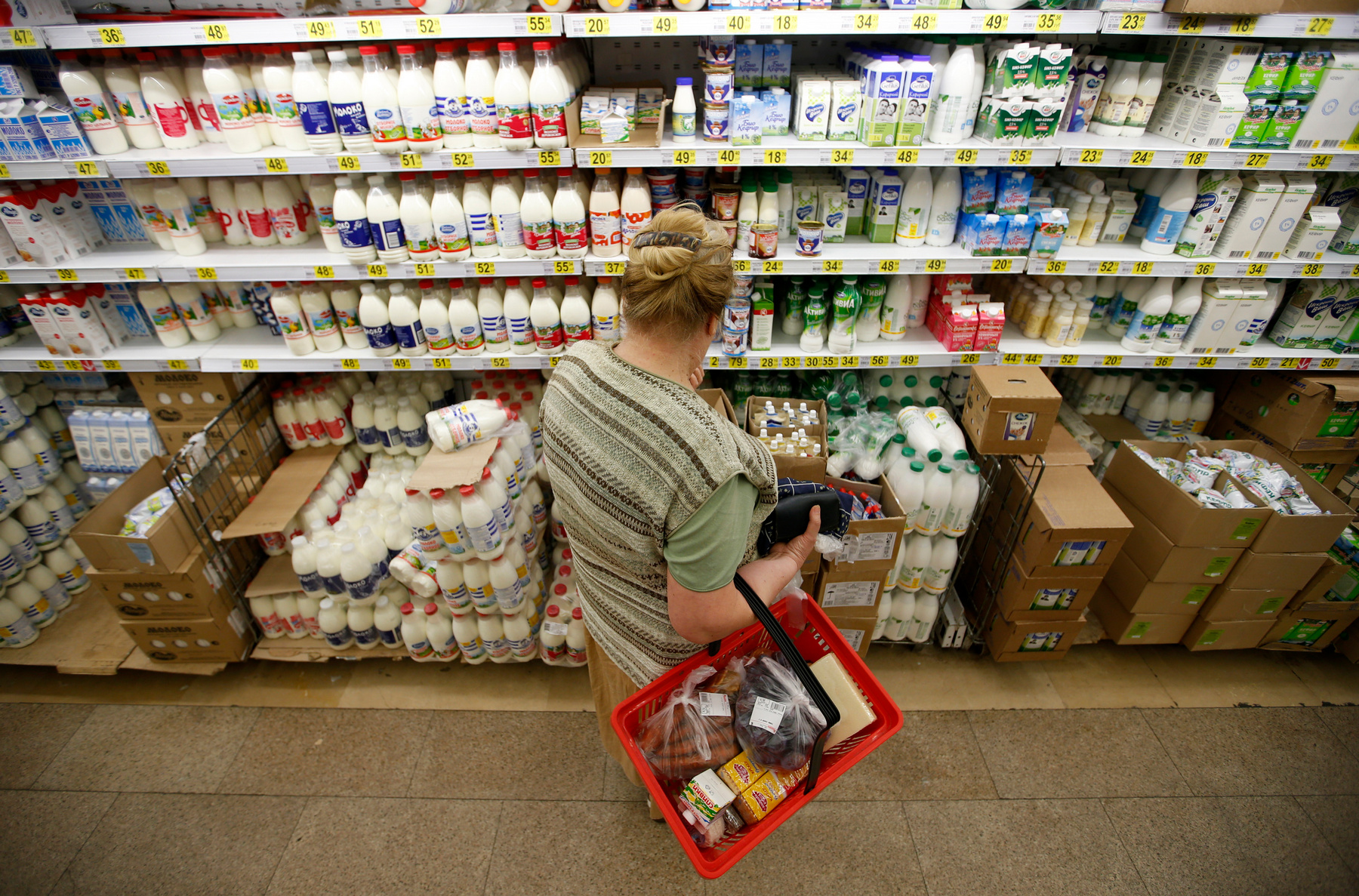Though Russia’s economy beat expectations last year, the government is now facing a new crisis: inflation. Annualized net inflation reached 5.67% in February. And there were far larger price increases for basic goods like pasta, eggs, or produce like apples.
Rising food costs are a huge political risk ahead of Duma elections in September. The average Russian spends nearly 30% of their income on food. With incomes falling over the course of 2020, the government has been striking agreements between retailers and producers to limit price hikes passed onto consumers. The government gave itself the right to set pricing for goods at the end of December; new legal controls over the pricing of major exports were passed in mid-February; a new floating tariff on wheat exports meant to discourage producers from selling as much abroad will take effect in April. Duma representatives have even discussed strengthening legal punishments for anyone “provoking” price increases by spreading unreliable information.
Since higher prices tend to reflect demand outstripping supply, rising prices should theoretically spur more investment into production. Holding prices down through state intervention becomes a problem when costs of production rise with inflation across the broader economy. Price controls thus tend to push the effects of inflation to other damaging areas. They lower the levels of investment into production the longer they’re in place. These underlying problems are all more salient now with a global surge in commodity prices from food to oil to industrial inputs like fertilizer. The political pressure to insulate the Russian economy from these inflationary forces risks creating a ‘new normal’ affecting a widening range of industries. Mishustin and the government are overseeing the next potential evolution in Russia’s statist political economy, one that will make the system even more brittle.
Who’s afraid of importing inflation?
Price stability has long been of central concern to macroeconomic policy in Moscow. That is a legacy of the inflationary crisis of the late Soviet economy. Levada Centre polling shows that with few and short-lived exceptions, price increases have been the public’s biggest economic concern since Putin came to power. During his first two terms as president, inflation often exceeded 10% annually. Yet this was managed by the increase in incomes brought by the country’s oil windfall. Though state coffers benefited from the oil boom, it also took place within a broader commodity supercycle. Back then, commodities of all stripes – oil, metals, minerals, and food – rose together in price. Russia depended on food imports to meet its needs, running a food trade deficit that rose past $10 billion annually by 2005. As prices for grains and other basic staples kept rising with oil, the cost was passed onto consumers and the food trade deficit doubled to $21.8 billion in 2008. The government opted to negotiate price freezes with producers on a voluntary basis to stabilize prices then, the same initial response seen in December 2020. It was an overtly political ploy seen as ineffective.
By 2009, price stability ceased to be the prime concern as the financial crisis hit and the commodity supercycle driving up prices ended. But the political impetus behind Russia’s agricultural protectionism and subsidy policies can be traced to the insecurity posed by the food trade deficit amid rising prices. The counter-sanctions regime on European food imports after the annexation of Crimea in 2014 marked a rapid acceleration of this dynamic. The government used the political crisis as cover to win concessions for agricultural producers, driving down Russia’s import levels. 2020 was the first time in Russia’s post-Soviet history that it was a net food exporter.
The cost of “food sovereignty”
Unlike 2007-2008, the current wave of food price inflation comes after 8 years of real and disposable income decline. It has been happening on the brink of what might become a new commodity price cycle. Even small changes in price pose problems. The driving assumption that erasing Russia’s food import deficit would improve price stability was poorly conceived. Rising levels of exports since 2014 shift producer incentives. For instance, if a wheat (or other grain) producer realize higher profits abroad than domestically and face higher levels of inflation for costs than their competitors while prices are rising, they want to sell abroad as much as possible. Quotas and tariff controls intended to restrict how much is exported by effectively taxing exports don’t change the incentive much. The basic lesson is that even for foodstuffs that Russia doesn’t export in large quantities, international prices filter into what producers quote retailers domestically, as they want to maximize profits, so will sell abroad if they see better returns.
Now that the government has the power to set consumer prices for these goods, it risks creating an unintended cascade of lost profits. One person’s spending is another person’s income. For instance, the government is considering a freeze on fertilizer prices to prevent passing on costs to growers at a time when fertilizer prices elsewhere have shot up as much as 48% year-on-year. Fertilizer producers claim existing price controls are adequate, there’s no need for a 2-3 month price freeze, and there’s no deficit of supply on the market though prices are rising. A price freeze would see a potential decline in demand for industrial goods and services from fertilizer producers. They’d be forgoing profits that could be invested. If a major industrial manufacturer were to lose orders as a result, it’s hard to imagine they wouldn’t then request some sort of offsetting mechanism such as a subsidy. The ripple effects grow as more interlocking industries end up losing out on profits. Even short-term measures set a precedent for future market interventions. These can unsettle business expectations with unintended consequences.
Russia’s investment crisis
The potential emergence of this new political economy of pricing dynamics for consumers is an outgrowth of the biggest problem for the Russian economy since 2013: investment levels are too low. It’s for this reason that Putin made such a big deal about increasing investment levels in real terms by 70% in 2030 at his recent meeting to discuss measures to stimulate investment. Nothing concrete was proposed. Instead, the government seems to be pressuring businesses to step up investment activity to generate better economic results, without addressing the consequences of policy measures holding prices down and risking future shortages (and therefore price inflation). Because of how ineffective the state has been at fostering investment due to perpetually weak levels of domestic demand, the regime is now trying to apply ‘manual control’ to the situation and coerce business into spending more.
Topping this all off, the inflation crisis has gotten bad enough that the Central Bank is now considering faster and more aggressive interest rate hikes than it had messaged in January-February, starting with a potential 0.25% hike in late April. In practice, these hikes reduce demand in the economy by making credit more expensive. Doing so would weaken demand and the consumer recovery and do little to address food price inflation since few people are borrowing to buy groceries. The stage is set for the escalating politicization of economic policy every time an ill-conceived measure fails.
Now that many consumer prices can be set politically, the state’s expanded its potential role determining the allocation of money into production in different sectors. Price-fixing is limited for now to salient consumer goods. Though these industries consume production from other sectors that are struggling with uncertainty. The regime is introducing more elements of a command economy to ensure the elections in September offer no surprises. But without adequate capacity to mobilize resources effectively. Now that the state has given itself this power over the consumer economy, it’s difficult to imagine it will relinquish its right to intervene whenever. And with every intervention, the investment climate is further distorted, bringin more tradeoffs between sectors. Business are learning fast that the best chance of growth and profit is now to win more concessions, subsidies, or other forms of state support.
Even if the current measures are lifted soon, a striking precedent has been set: the economy must not be affected by external price levels for goods. Unfortunately for the regime, their approach to price stability brings … instability. This is a new kind of crisis, with no clear end in sight without significant reform and a change in economic thinking.










